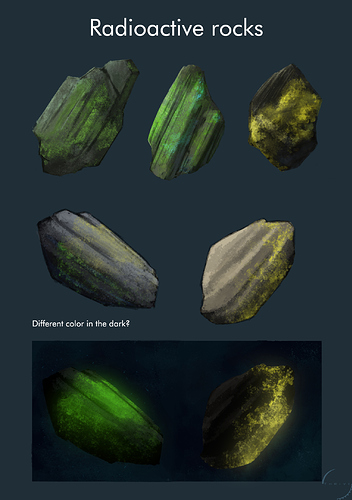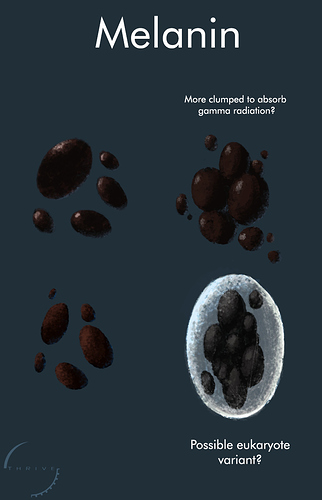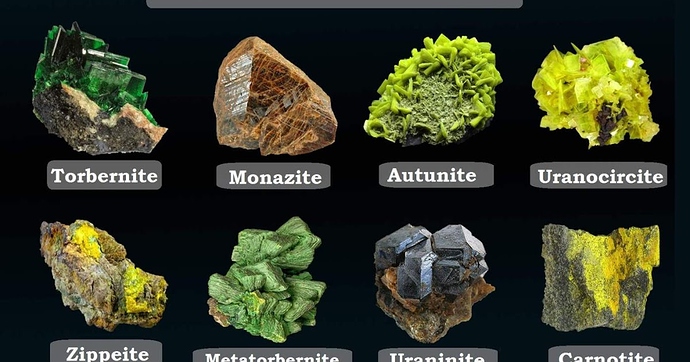After being brought up by Tjwhale in response to my post in Organelles / Mutations - #22 by Buckly, I have decided to approach this concept with some of my own ideas in an attempt to move it closer to finalization and implementation.
To begin, I really like Tjwhale’s idea of free-floating chunks periodically sending out radiating pulses of energy, though I’m not entirely sure the variable intensity would be necessary but it should cause much harm. From what I understand about the articles I have read online, radiosynthesis seems to be functionally similar to photosynthesis. I am going to go out on a branch here and assume
that they will consume and produce the same compounds, but instead of using visible spectrum/UV they will require higher frequency radiation to catalyze the reaction.
Below are two different concepts I have devised on how radiotrophic parts may function.
Concept A:
Going by my assumption that radiosynthesis is functionally similar to photosynthesis, these following stats are created to reflect that. Note that I am not exactly certain how to measure radiation within the game as a variable at the moment so for now required radiation is indeterminate. Also worth noting these stats are just to provide a general idea, we will need to test to figure out what seems and feels right.
Melaniplast(?):
0.07 CO2 + γ rad → Glucose 0.08 I’m sure everyone is tired of seeing “plast” but it seemed to be the most realistic choice.
Melanin Complex(???):
0.07 CO2 + γ rad → Glucose 0.02 I have no idea what to call the prokaryotic counterpart.
These parts here would generate glucose when in proximity to radioactive objects, and may offer a passive radiation resistance as a bonus, nifty!
Edit: Instead of using a direct variable, we could potentially just have the part generate a flat amount of glucose whenever the cell is hit by a radiation pulse, assuming that is going to be the primary means of obtaining radiation. If we go with this route, we will need to balance the glucose production based on the rate of pulses let out by the minerals so I dont have any solid numbers for that yet.
Concept B:
This idea is a bit more unusual in that instead of staying in constant contact with radiation, the cell would be able to “charge” their melanin. Irradiated melanin according to an article I read seems to be boosted in it’s ability to reduce NADH, which is important for energy production. Basically, Once your cell is hit with a pulse of radiation from any source, your radiotrophic parts would become charged and begin producing glucose at a constant rate for a time until they must be charged again. This would create an interesting dynamic where you could freely leave your source of energy and explore while still processing the radiation, until you find another. It’s somewhat similar to compound storage, but radiation instead.
The stats for this would likely be just like Concept A, but instead of requiring a set variable radiation amount, it would just start the process while irradiated.
With that out of the way, I’ve noticed that folks have debated on what sound irradiated materials should make to communicate the fact that they are irradiated. One of my favorite examples of radiation sounds I’ve encountered in videogames is the sounds a material called phazon makes in the metroid prime series.
Now obviously we would probably want the sound to be far less noisy and oppressive, but I would think that having a similar chime-like sound would make it sound so cool, and less jarring than a giger counter. Something our sound artists could experiment with for sure!
Edit: After a little contemplation I think it would be suitable if we forwent the implementation of a prokaryotic variant (Seriously what the heck would we call it?) and left radiosynthesis for eukaryotes. My reasoning is that since prokaryotes have their own special energy source, rustycyanin, it is only right that eukaryotes have something special to call their own. It also saves us the effort of trying to balance two different variants of the same part which can be alot of work. Also worth mentioning that as far as I have read, there are currently no examples of prokaryotic radiotrophs in reality, though I may be wrong.



![Phazon Radiation Metroid Prime Music Extended [Music OST][Original Soundtrack]](https://thrivedevforum-uploads.b-cdn.net/original/2X/9/9a24c1baea2568b87f8a90f3731712476ee3734b.jpeg)
